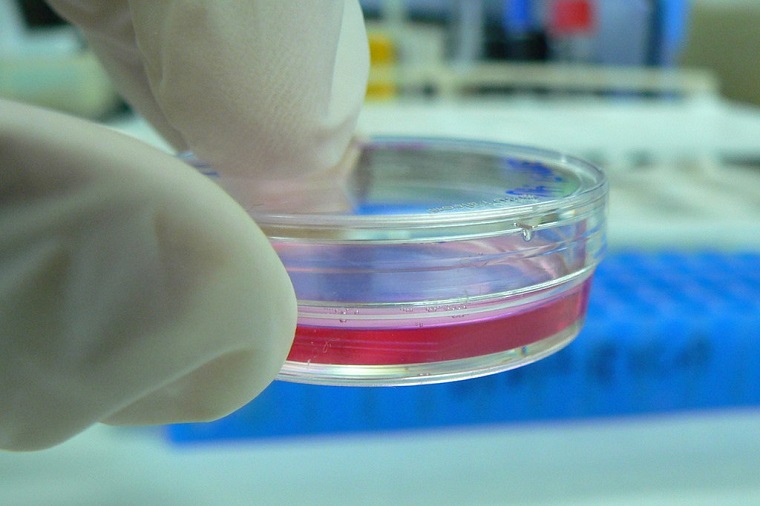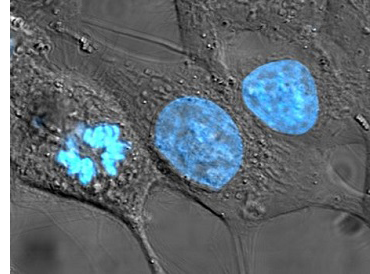The “Goldiloxygen” Zone: Finding the Oxygen “Sweet Spot” for Growing Human Cells in the Lab
By Victoria Sanderson
5 June 2019

The human body is made up of 37 trillion cells and each of these cells serves a specific function. These tiny powerhouses of life have long intrigued Prof. Jim Uniacke in the Department of Molecular and Cellular Biology. He and his research team study how cells respond to changes in their environment, gaining important insights about how cells function in both health and disease.
“I love discovering something new about how life works. I’m driven by that ‘wow’ factor of learning a new mechanism,” says Uniacke.
Uniacke and his team recently made a discovery that could change how we study cells.
Much of our current understanding of how human cells work comes from studying cells that have been grown or “cultured” in the lab. Cell culture techniques were pioneered in the 1950s, providing an invaluable model system to study basic cell physiology and biochemistry, as well as aging, response to drugs, interactions with pathogens and much more. Similar to caring for a pet fish, cells cultured in the lab are kept alive by regular “feeding” that provides nutrients for growth, and removal of waste products to prevent toxicity. Over the years, cell culture conditions have been optimized to support cell growth and include a temperature of 37°C (the core temperature of the human body), a humidity level of 85-95%, and a CO2 concentration of 5%. In this environment, cells will readily grow and multiply, and appear healthy under a microscope.

one of the oldest established human cell lines known as “HeLa”
But there is one condition that isn’t typically considered during cell culture: the amount of oxygen. Inside the human body, cells experience oxygen levels ranging from 3 to 10%, depending on the organ. In contrast, cells grown in the lab are routinely grown at ambient oxygen levels of 21%. This discrepancy led Uniacke and PhD student Sara Timpano to wonder what effect higher than normal oxygen levels might be having on cultured cells. Surprisingly, a robust comparison of cells grown at ambient versus typical human body levels had never been carried out.
“Oxygen is necessary for cells to survive, but it can also generate reactive oxygen species that are dangerous to the cell. At high oxygen levels, we expect that cells would show more signs of stress because they’re constantly putting out fires and just trying to survive,” explains Uniacke.
And that is precisely what they found. After growing four different cell types at oxygen levels ranging from 1 to 21%, the researchers observed multiple hallmarks of cellular stress, including DNA damage and changes to the structure and function of mitochondria, which are the structures responsible for cellular respiration and energy production.
Importantly, Uniacke and Timpano noticed that cells are highly stressed at both high and low oxygen. They identified a “sweet spot” between 5 and 8% oxygen where cells grew optimally, which matches levels seen in human tissues.
Historically, scientists have accepted ambient air as a suitable growth condition because cells appear healthy. However, without side-by-side comparison to cells grown at physiologically-relevant oxygen conditions, it is impossible to know if ambient air is truly optimal or not.
Now that Uniacke and Timpano have demonstrated that cells function optimally between 5 and 8% oxygen, one might conclude that all cell culture should be done within this range. But there is a complicating factor: lowering oxygen levels below 21% requires a special chamber that flushes out oxygen to very low levels, and few research labs have access to this very expensive equipment. According to Uniacke, however, these findings do not necessarily mean every researcher needs grow cells at 5-8% oxygen. Instead, these results should be a potential factor for consideration in studies where oxygen levels may be relevant to the conclusions being drawn.
To expand upon their landmark findings, Uniacke and his lab plan to make use of modern proteomic techniques to carry out detailed analyses of gene expression in cells grown under various oxygen conditions. This will help to inform researchers just how impactful high oxygen levels might be, and which fields of study will be most impacted.
“I think we’re going to see more and more research about this topic coming up,” says Uniacke.
And for the researchers out there conducting cell culture, simply remember that your cells might be happiest growing within the “Goldiloxygen zone”: where oxygen levels are not too high and not too low, but just right.
This study was funded by the Natural Science and Engineering Research Council of Canada.
Read the full study in the Federation of American Societies for Experimental Biology (FASEB) Journal.
Read about other CBS Research Highlights.